日本文化介绍英文版
日本文化传统英文介绍
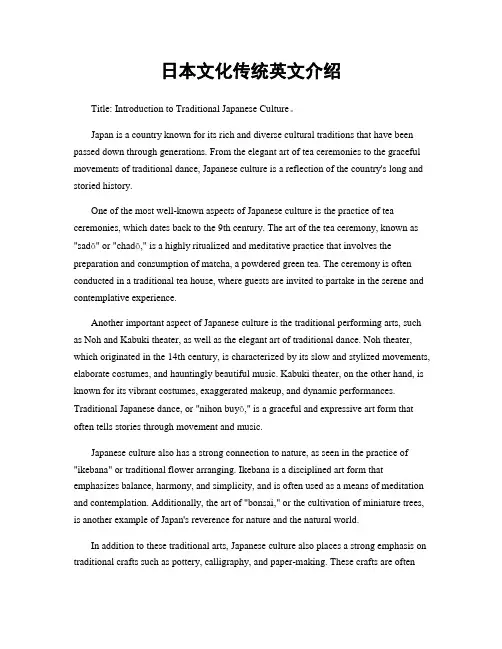
日本文化传统英文介绍Title: Introduction to Traditional Japanese Culture。
Japan is a country known for its rich and diverse cultural traditions that have been passed down through generations. From the elegant art of tea ceremonies to the graceful movements of traditional dance, Japanese culture is a reflection of the country's long and storied history.One of the most well-known aspects of Japanese culture is the practice of tea ceremonies, which dates back to the 9th century. The art of the tea ceremony, known as "sadō" or "chadō," is a highly ritualized and meditative practice that involves the preparation and consumption of matcha, a powdered green tea. The ceremony is often conducted in a traditional tea house, where guests are invited to partake in the serene and contemplative experience.Another important aspect of Japanese culture is the traditional performing arts, such as Noh and Kabuki theater, as well as the elegant art of traditional dance. Noh theater, which originated in the 14th century, is characterized by its slow and stylized movements, elaborate costumes, and hauntingly beautiful music. Kabuki theater, on the other hand, is known for its vibrant costumes, exaggerated makeup, and dynamic performances. Traditional Japanese dance, or "nihon buyō," is a graceful and expressive art form that often tells stories through movement and music.Japanese culture also has a strong connection to nature, as seen in the practice of "ikebana" or traditional flower arranging. Ikebana is a disciplined art form that emphasizes balance, harmony, and simplicity, and is often used as a means of meditation and contemplation. Additionally, the art of "bonsai," or the cultivation of miniature trees, is another example of Japan's reverence for nature and the natural world.In addition to these traditional arts, Japanese culture also places a strong emphasis on traditional crafts such as pottery, calligraphy, and paper-making. These crafts are oftenpassed down through families and communities, and are valued for their beauty, precision, and connection to the past.Overall, traditional Japanese culture is a reflection of the country's deep respect for history, nature, and the arts. From the serene beauty of tea ceremonies to the vibrant performances of traditional theater, Japan's cultural traditions continue to inspire and captivate people around the world.。
日本传统文化英文作文
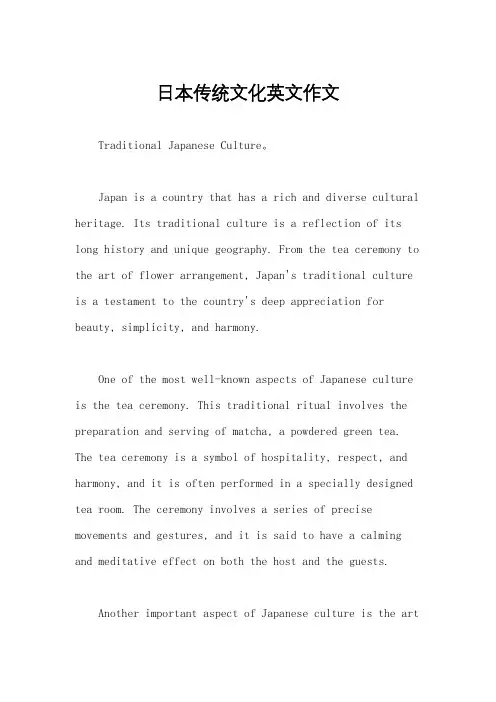
日本传统文化英文作文Traditional Japanese Culture。
Japan is a country that has a rich and diverse cultural heritage. Its traditional culture is a reflection of its long history and unique geography. From the tea ceremony to the art of flower arrangement, Japan's traditional culture is a testament to the country's deep appreciation for beauty, simplicity, and harmony.One of the most well-known aspects of Japanese culture is the tea ceremony. This traditional ritual involves the preparation and serving of matcha, a powdered green tea. The tea ceremony is a symbol of hospitality, respect, and harmony, and it is often performed in a specially designed tea room. The ceremony involves a series of precise movements and gestures, and it is said to have a calming and meditative effect on both the host and the guests.Another important aspect of Japanese culture is the artof flower arrangement, or ikebana. Ikebana is a form of art that emphasizes the beauty of simplicity. It involves the arrangement of flowers, leaves, and other natural materials in a way that creates a harmonious and balanced composition. Ikebana is often used in traditional Japanese homes and temples as a way to create a peaceful and serene atmosphere.In addition to the tea ceremony and ikebana, Japan's traditional culture also includes a variety of other art forms, such as calligraphy, painting, and pottery. Calligraphy, or shodo, is the art of writing Japanese characters with a brush and ink. It is considered a form of meditation and is often used as a way to express one's emotions and thoughts. Painting, or sumi-e, is a form ofink wash painting that emphasizes the beauty of simplicity and the natural world. Pottery, or yakimono, is a form of ceramic art that has a long history in Japan and is knownfor its delicate beauty and functionality.Overall, Japan's traditional culture is a reflection of its deep appreciation for beauty, simplicity, and harmony. From the tea ceremony to the art of flower arrangement,these traditional practices have been passed down from generation to generation and continue to be an important part of Japanese life today.。
【全面版】英文 介绍日本文化PPT文档
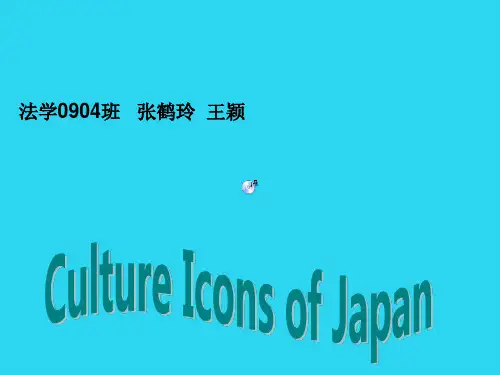
In Japanese, the cherry is called ”Sakura”, which is generally believed to be a corruption of the word “ Sakura” (blooming ) from the name of Princess KonoHana-Sakura-Hime.
There is often a misconception(误解) by some that Geisha are prostitutes(娼妓), but nothing could be further from the truth Geisha are refined and cultured girls and woman who are highly trained in a variety of traditional skills. Besides playing Shamisen ( 三弦琴), singing, and dancing, the Geisha perform the Japanese tea ceremony, and are well versed(精通的) in the art of conversation. Many learn to speak English to entertain Western guests.
This Mt. Fuji is beautiful and magic, isn’t it?
Many learn to speak English to entertain Western guests. In Japanese, the cherry is called ”Sakura”, which is generally believed to be a corruption of the word “ Sakura” (blooming ) from the name of Princess Kono-Hana-Sakura-Hime. Maneki Neko Located almost in the center of the country, this well-proportioned cone-shaped mountain has been worshiped by the Japanese people since ancient times, and is a well-known symbol of Japan in other countries. The scroll he carries bears the congenial(和蔼的) message. With a right paw raised he welcomes wealth or luck. Maneki Neko 法学0904班 张鹤玲 王颖 There is often a misconception(误解) by some that Geisha are prostitutes(娼妓), but nothing could be further from the truth Geisha are refined and cultured girls and woman who are highly trained in a variety of traditional skills. Welcoming Cat, Lucky Cat, Money cat , Fortune Cat Many learn to speak English to entertain Western guests. With economic, cultural and religious influence from neighboring Asian states, Japan has produced a unique culture of its own. 法学0904班 张鹤玲 王颖 法学0904班 张鹤玲 王颖 Located almost in the center of the country, this well-proportioned cone-shaped mountain has been worshiped by the Japanese people since ancient times, and is a well-known symbol of Japan in other countries. “Maneki Neko” means “beckoning(召唤) cat” in the Japanese language. With economic, cultural and religious influence from neighboring Asian states, Japan has produced a unique culture of its own. Fuji, however, soars into the sky alone.
日本的介绍英语作文
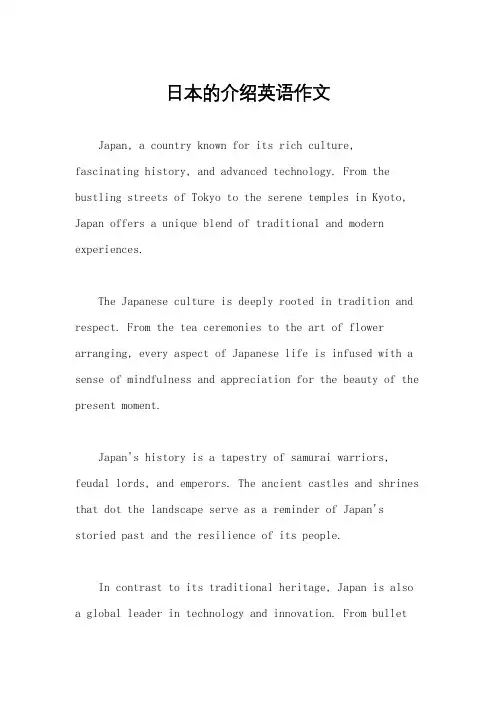
日本的介绍英语作文Japan, a country known for its rich culture,fascinating history, and advanced technology. From the bustling streets of Tokyo to the serene temples in Kyoto, Japan offers a unique blend of traditional and modern experiences.The Japanese culture is deeply rooted in tradition and respect. From the tea ceremonies to the art of flower arranging, every aspect of Japanese life is infused with a sense of mindfulness and appreciation for the beauty of the present moment.Japan's history is a tapestry of samurai warriors, feudal lords, and emperors. The ancient castles and shrines that dot the landscape serve as a reminder of Japan's storied past and the resilience of its people.In contrast to its traditional heritage, Japan is also a global leader in technology and innovation. From bullettrains to robots, Japan is at the forefront of cutting-edge advancements that continue to shape the world.The natural beauty of Japan is also a sight to behold. From the snow-capped peaks of Mount Fuji to the cherry blossoms that blanket the country in spring, Japan's landscapes are diverse and breathtaking.The cuisine of Japan is a culinary delight, with sushi, ramen, and tempura being just a few of the many delicious dishes that have captivated the world.In conclusion, Japan is a country of contrasts, where ancient traditions coexist with modern marvels, and where the past and the future converge in a harmonious blend. It is a place that offers something for everyone, whether you are a history buff, a tech enthusiast, or a nature lover. Japan truly is a one-of-a-kind destination that leaves a lasting impression on all who visit.。
日式文化介绍英文作文模板
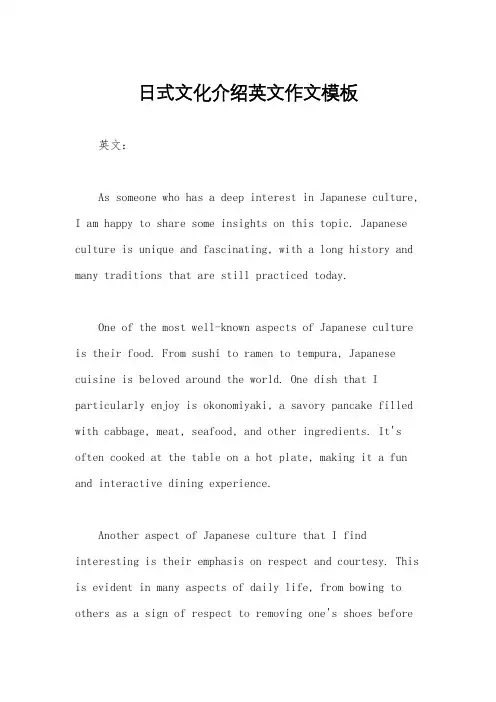
日式文化介绍英文作文模板英文:As someone who has a deep interest in Japanese culture, I am happy to share some insights on this topic. Japanese culture is unique and fascinating, with a long history and many traditions that are still practiced today.One of the most well-known aspects of Japanese culture is their food. From sushi to ramen to tempura, Japanese cuisine is beloved around the world. One dish that I particularly enjoy is okonomiyaki, a savory pancake filled with cabbage, meat, seafood, and other ingredients. It's often cooked at the table on a hot plate, making it a fun and interactive dining experience.Another aspect of Japanese culture that I find interesting is their emphasis on respect and courtesy. This is evident in many aspects of daily life, from bowing to others as a sign of respect to removing one's shoes beforeentering a home. Even the way that business cards are exchanged is done with great care and respect.In terms of entertainment, Japanese culture has also made an impact around the world. Anime and manga, for example, have gained a huge following outside of Japan. One of my favorite anime series is "Your Lie in April," which tells the story of a young pianist who rediscovers his love for music with the help of a talented violinist.Overall, Japanese culture is rich and diverse, with many fascinating aspects to explore. Whether it's through food, traditions, or entertainment, there's something for everyone to appreciate.中文:作为一个对日本文化深感兴趣的人,我很高兴能够分享一些关于这个话题的见解。
日本传统介绍英文作文
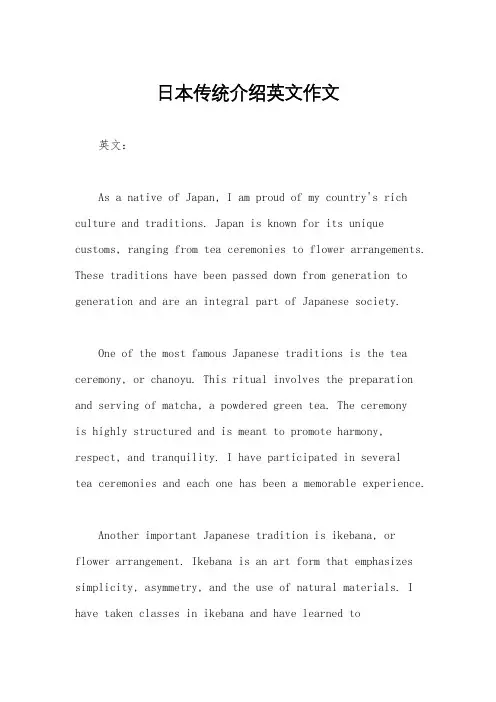
日本传统介绍英文作文英文:As a native of Japan, I am proud of my country's rich culture and traditions. Japan is known for its unique customs, ranging from tea ceremonies to flower arrangements. These traditions have been passed down from generation to generation and are an integral part of Japanese society.One of the most famous Japanese traditions is the tea ceremony, or chanoyu. This ritual involves the preparation and serving of matcha, a powdered green tea. The ceremonyis highly structured and is meant to promote harmony, respect, and tranquility. I have participated in severaltea ceremonies and each one has been a memorable experience.Another important Japanese tradition is ikebana, or flower arrangement. Ikebana is an art form that emphasizes simplicity, asymmetry, and the use of natural materials. I have taken classes in ikebana and have learned toappreciate the beauty of arranging flowers in a way that highlights their natural form.In addition to these well-known traditions, there are many other aspects of Japanese culture that are worth exploring. For example, Japanese cuisine is renowned forits freshness and attention to detail. From sushi to ramen, there is something for everyone to enjoy.Overall, I believe that Japan's traditions are an important part of our cultural heritage and should be celebrated and preserved for future generations.中文:作为日本人,我为我的国家丰富的文化和传统感到自豪。
描述日本风俗文化英语作文
Title: Embracing the Unique Customs andCulture of JapanJapan, an island nation steeped in history and tradition, presents a fascinating tapestry of customs and culture. From the elegant precision of its tea ceremony to the vibrant energy of its festivals, Japan offers a rich palette of experiences that are both enchanting and enlightening.The heart of Japanese culture lies in its respect for tradition and reverence for nature. This is reflected in the meticulous attention to detail in all aspects of daily life, whether it's the meticulous care taken in preparing a meal or the precision with which tea is poured during the tea ceremony. The tea ceremony, known as "sado," is notjust about drinking tea; it's an elaborate ritual that involves the harmonious interaction of host and guest, the appreciation of the beauty of nature, and the pursuit of inner peace.Another hallmark of Japanese culture is its emphasis on community and collective harmony. This is evident in the way Japanese people greet each other with bows and politephrases, demonstrating respect and consideration for others. The concept of "wa," which translates to harmony or unity,is ingrained in Japanese society and is reflected invarious aspects of life, from social interactions to theway businesses are conducted.Festivals and celebrations are an integral part of Japanese culture, with each season marked by special events and traditions. The cherry blossom viewing, known as "sakura-viewing," is a national obsession, with people flocking to parks and temples to admire the delicate beauty of the flowers. The autumn moon viewing, on the other hand, is a time for family reunions and the appreciation of thefull moon against the backdrop of autumn foliage.The visual arts of Japan are also a testament to itsrich cultural heritage. From the delicate brushstrokes of traditional Japanese painting to the intricate carvings of lacquerware, Japanese artists have perfected the art of combining beauty and functionality. The art of origami, the folding of paper into intricate shapes, is another exampleof Japanese creativity and craftsmanship.In conclusion, Japan's customs and culture are atapestry of tradition, harmony, and natural beauty. Fromthe precision of its tea ceremony to the vibrantcelebrations of its festivals, Japan offers a unique and enchanting experience that leaves a lasting impression on those who visit. Embracing these customs and traditions,one can truly appreciate the depth and richness of Japanese culture.**拥抱日本独特的风俗文化**日本,这个岛屿国家拥有丰富的历史和传统,展现了一幅迷人且多姿多彩的风俗文化画卷。
最新日本文化的介绍(英语)
ethnic group
The Japanese nation basically consists of the Yamato, the Ryukyu, and the Ainu.
Yamato constitutes the main body of the Japanese nation, accounting for about 99.9% of the current total population of Japan
Agricultural productie development of commodity economy promotes market prosperity
It is a turbulent social transition period, and the divided country became a unity.
In 1868-1890
In 1914-1918 In 1939-1945
After the war
Economy
TOYOTA HONDA
Economy
Economy
Agriculture
Only 12% of Japan‘s land can grow food. Japanese agriculture is a highly protected industry , and because of the lack of land and labor, they use high-tech farming. Unit land production is the world's largest.
1. Located on the east coast of the Asian continent.
日本的文化英语作文
日本的文化英语作文Japanese culture is a fascinating mosaic of ancient traditions and modern innovations. It is a reflection of the Japanese people's deep respect for their heritage and their embrace of new ideas. From its rich artistic heritage to its unique social customs, Japanese culture is deeply rooted in the values of harmony, respect, and perseverance.One of the most striking aspects of Japanese culture is its traditional arts. These include practices such as calligraphy, painting, pottery, and origami. Calligraphy, known as shodo in Japan, is not only a form of artistic expression but also a means of practicing discipline and focus. Japanese painting, with its delicate brushstrokes and use of natural motifs, showcases the country's appreciation for the beauty of nature. Pottery, particularly the kiln techniques used in regions like Arita and Seto, has a long history and is cherished for its beauty and functionality. Origami, the art of folding paper, is both a traditional pastime and a significant part of Japanese cultural events.Japanese cuisine, known as washoku, is world-renowned for its delicate flavors, intricate presentation, and emphasis on seasonal ingredients. Dishes such as sushi, tempura, and ramen have gained global popularity, reflecting the influence of Japanese cuisine on world food cultures. The art of tea ceremony, orchanoyu, is another important aspect of Japanese culture, symbolizing harmony, respect, and tranquility.Social customs in Japan are characterized by a strong sense of etiquette and respect. The concept of omotenashi, or hospitality, is deeply ingrained in Japanese society. This is evident in the attention to detail in service industries, the importance of gift-giving, and the practice of bowing as a form of greeting. The Japanese people's respect for elders and their commitment to maintaining harmony in social interactions are also notable aspects of Japanese culture.In recent years, Japanese culture has also influenced global trends in fashion, animation, and technology. Japanese street fashion, with its bold andinnovative styles, has captured the imagination of fashion enthusiasts worldwide. Anime and manga, Japanese forms of graphic storytelling, have become global phenomena, introducing Japanese cultural elements to audiences far and wide.In conclusion, Japanese culture is a unique blend of tradition and modernity. Its rich heritage and innovative practices continue to inspire and captivate people around the world. The Japanese people's dedication to preserving their cultural traditions while embracing new ideas is a testament to the dynamic and fascinating nature of Japanese culture.中文翻译:日本文化是一幅由古老传统和现代创新构成的迷人马赛克。
日本生活文化介绍英文作文
日本生活文化介绍英文作文英文:Living in Japan is a unique and enriching experience. The culture is rich with traditions and customs that have been passed down for centuries. One of the most fascinating aspects of Japanese life is the attention to detail and the emphasis on hospitality. Whether it's enjoying atraditional tea ceremony or staying in a ryokan, the Japanese take pride in providing a high level of service and ensuring that guests feel welcome and comfortable.Another interesting aspect of Japanese culture is the focus on harmony and respect. This can be seen in the way people interact with each other, as well as in the design of public spaces and the natural environment. For example, the concept of "wa" or harmony is deeply ingrained in Japanese society, and it is reflected in the way people strive to maintain peaceful relationships and avoid conflict.In addition, the food culture in Japan is truly exceptional. From fresh sushi and sashimi to hearty bowls of ramen, Japanese cuisine is diverse and delicious. I have had the pleasure of trying many different types of Japanese dishes, and each one has left a lasting impression on me. The attention to presentation and the use of seasonal ingredients make dining in Japan a memorable experience.Living in Japan has also given me the opportunity to participate in various cultural activities, such as wearing a kimono, learning the art of origami, and attending traditional festivals. These experiences have allowed me to gain a deeper understanding and appreciation for Japanese culture.Overall, life in Japan is a wonderful blend oftradition and modernity, and I feel fortunate to have the chance to immerse myself in such a unique and captivating culture.中文:生活在日本是一种独特而丰富的体验。
- 1、下载文档前请自行甄别文档内容的完整性,平台不提供额外的编辑、内容补充、找答案等附加服务。
- 2、"仅部分预览"的文档,不可在线预览部分如存在完整性等问题,可反馈申请退款(可完整预览的文档不适用该条件!)。
- 3、如文档侵犯您的权益,请联系客服反馈,我们会尽快为您处理(人工客服工作时间:9:00-18:30)。
Cherry blossom is an omen of good fort une and is also an emblem of love, affect ion and represents spring. Cherry blosso ms• are an enduring metaphor for the fle eting nature of life, and as such are freq uently depicted in art.
• The folk dances and traditional art can’t do wi thout kimono, for the kimono can display the e legancy and beauty of Japanese women. Japan ese people always wear business suit when the y work, especially for people work outside and salesman, their companies demand the worker must wear business suit.
attracts mang tourists.
Flower Viewing
"Hanami"is the Japanese traditional custom of enjoying the beauty of flowers, "flower" in this case almost always meaning cherry blossoms or ume blossoms. From the end of March to early May, sakura bloom all over Japan.
Cherry Blossom
Cherry Blossoms is a national flower of Japen.In the middle of every march to mid April ,is Japen from the south to the north of cherry blossoms season.Every year
Symbolism
In Japan cherry blossoms also symbolize clouds due to their nature of blooming en masse, besides being an •enduring metaphor for the ephemeral nature of life, an aspect of Japanese cultural tradition that is often associated •with Buddhistic influence, and which is embodied in the concept of mono no aware. The association of the cherry blossom with mono no aware dates back to 18th century scholar Motoori Norinaga. The transience of the blossoms, the extreme beauty and quick death, has often been associated with mortality; for this reason, cherry blossoms are richly symbolic, and have been utilized often in Japanese art, manga, anime, and film, as well as at musical performances for ambient effect. There is at least one popular folk song, originally meant for the shakuhachi (bamboo flute), titled "Sakura", and several pop songs. The flower is also represented on all manner of consumer goods in Japan, including kimono, stationery, and dishware
• The kimono we see today mostly inherit the co stume feature of Jianghu dynasty. Japanese ful ly and perfectly express their impression for ar t on kimono.
The blossom forecast , sakurazensen, literally cherry blossom front is announced each year by the weather bureau, and is watched carefully by those planning hanami as the blossoms only last a week or two.
Kimono
• The kimono is the traditional costume of Japan ese nation. It was based on the costume of Tan g dynasty of China and gradually developed th rough more than 1000 years hisan, hanami mostly consists of having an outdoor party beneath the sakura during daytime or at night. Hanami at night is called yozakura . In many places such as Ueno Park temporary paper lanterns are hung for the purpose of yozakura.
